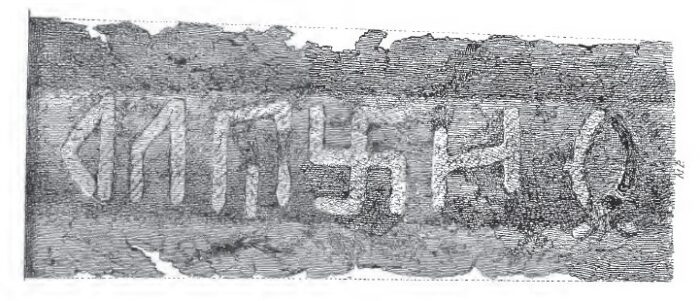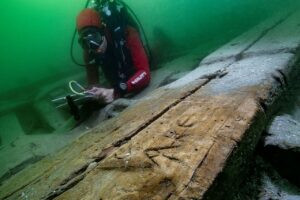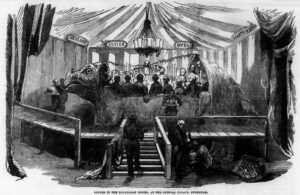Steven Spielberg’s portrayal of the Nazis in the Indiana Jones movies is surprisingly accurate. The fictional Nazi villains’ attempts to secure the Ark of the Covenant and the Holy Grail were based on real people with the oddest ambition: to weaponize archaeology.
A disturbed mind
In the early 1900s, a curious boy grew up in an ordinary family in Munich. At age 10, he already buried himself in books about politics and religion. A bright future beckoned, before his life took a dark turn. His parents were unable to financially support his academic endeavors, and he later failed to join the military. Angry with the world, he started to form dangerous ideas. This boy was Heinrich Himmler.

Heinrich Himmler. Photo: German Federal Archive
In the aftermath of World War I, Himmler consumed fringe literature that focused on the occult, antisemitism, and the racial superiority of the “Nordic” race. After joining the Nazi Party and climbing the ranks to sit at Hitler’s side, he saw an opportunity to manipulate academia.
Himmler eventually became the head of the Schutzstaffel (the SS, an elite paramilitary wing of the Nazi party) in 1929. This allowed him to indulge his occultist beliefs and wild theories. In 1935, he established a special “scientific” department called Ahnenerbe, which translates as “something inherited from the forefathers.” Later, it was renamed the Research and Teaching Community in Ancestral Heritage.
Promoting Nazi ideology
The department’s primary aim was to promote Nazi ideology through the reinterpretation of ancient history, focusing on the supposed superiority of the Germanic race. The Ahnenerbe tried to find archaeological and anthropological evidence of Germanic civilizations to legitimize Germany’s territorial expansion.
Hitler claimed that the German people descended from a pseudoscientific superior race called the Aryans. The term was originally used to describe Indo-Iranian groups in Asia, but was appropriated by 19th-century writers and philosophers like Arthur de Gobineau and Houston Stewart Chamberlain to describe a proto-Indo-European race superior to all others. These ideas formed the basis for Nazi ideology.
The Nazis believed the Aryans were a Nordic people, flaxen-haired, white, physically strong, and the founders of civilization. The hypothesis was that the Aryans/Germanic people built the Northern European culture, from music, art, and religion to value systems and forms of politics.
Hitler admired Nordic and Greco-Roman cultures, which he claimed emerged from a single Germanic Aryan race.

The Ahnenerbe logo.
Ahnenerbe conducted pseudoscientific research, ranging from archaeology to anthropology, to support Nazi racial theories.
Himmler himself stated:
The one and only thing that matters to us, and the thing these people are paid for by the State, is to have ideas of history that strengthen our people in their necessary national pride. In all this troublesome business, we are only interested in one thing — to project into the dim and distant past the picture of our nation as we envisage it for the future. Every bit of Tacitus in his Germania is tendentious stuff. Our teaching of German origins has depended for centuries on a falsification. We are entitled to impose one of our own at any time.
Himmler hoped to use this “science” to create a new religion. As time went by, what was originally propaganda became fact in Himmler’s mind. He started to believe his lies.
Pseudoarchaeology
With considerable funding, the Ahnenerbe started digging. Ambitious young archaeologists saw this as an opportunity to launch their careers. Assien Bohmers, an eager Dutch archaeologist, got a job excavating Palaeolithic sites. Bohmer participated in a dig in Mauern, Bavaria, that unearthed the remains of a Cro-Magnon female who bore “similar” features to German women. The Nazi archaeologists claimed that “the excavations at Mauern have revealed that the Cro-Magnon race must have developed in greater Germany.”
Discoveries such as these stirred up excitement in Germany. Writer Bettina Arnold gives an example of a flyer that promoted the importance of archaeology:
Every single find is important because it represents a document of our ancestors! Keep your eyes open, for every Volksgenosse [fellow German] can contribute to this important national project! Do not assume that a ceramic vessel is useless because it falls apart during excavation. Carefully preserve even the smallest fragment!
‘Responsibility with respect to our indigenous prehistory must again fill every German with pride!’
Other sites, such as Externsteine and Biskupin, were also used by the propaganda machine.
Externsteine is a series of striking sandstone rock formations in northern Germany, which gained symbolic importance to the Nazis because of their association with ancient Germanic and pagan traditions. The Nazis viewed the site as a symbol of Germany’s pre-Christian, “pure,” past, which they believed was rooted in a spiritual connection to nature and ancestral heritage. It became the site of Nazi cult rituals.
Excavations in Biskupin, Poland, supposedly showed that the local populations were conquered by the Aryans. Hitler used this as part of his justification for the invasion.
The search for the Holy Grail
Just like in Indiana Jones, the Nazis tried searching for the Holy Grail. This brings us to the bizarre tale of Otto Rahn. Rahn was holed up in a little apartment writing about his greatest passion: Arthurian legend and the Holy Grail. He spent what little money he had trying to track down the Holy Grail, even traveling around France to learn about the Grail from oral tradition.
German folktales state that the Grail was a stone, not a chalice, and Rahn read of a heretical Christian sect called the Cathars who received a stone from heaven. He believed this was the Grail. However, he ran out of money before he could proceed any further with his research. Then came the answer to his prayers.

A supposed swastika on a 9th-century sword. Photo: George Stephens
Himmler also wanted to find the Grail; according to legend, it could provide eternal life. Himmler also wanted to prove that Christ was not a Jew but an Aryan. So, he offered Rahn a job with a handsome salary to search for the Grail. Rahn could not refuse, but his new work came at a cost. The Nazis tampered with his writing, inserting passages about Jews destroying culture. Rahn was also asked to prove his ethnic purity. He was gay, and paranoia that the Nazis would discover this eventually led him to commit suicide.
Himmler had lost an archaeologist but continued the search. In Spain, an obscure monastery in Montserrat featured a local legend that the monks held the Holy Grail in the mountain. Himmler visited the monastery, but returned to Germany empty-handed.
Aryans in Tibet
Perhaps one of the oddest Ahnenerbe expeditions was to Tibet. In 1938, a team led by Ernst Schaefer, a zoologist and SS officer, traveled to Tibet under the guise of scientific research. While the team studied the local flora and fauna, they also searched for archaeological evidence that could prove Nazi theories about the Aryan “race.” They believed Tibet could have been the Aryan homeland. They measured and studied the physical features of locals and observed local customs.
South America
Even before the establishment of Ahnenerbe, SS officers and archaeologists were trying their best to find evidence of German superiority. Edmund Kiss was obsessed with the idea that Aryans were descended from survivors of Atlantis. Kiss believed these survivors spread across the globe and built civilizations.
One of the largest archaeological sites on the South American continent is near Lake Titicaca in Bolivia. The site was used for astronomy, contained impressive carvings, monoliths, subterranean temples, and high walls. Kiss refused to believe a pre-Columbian culture had built the complex site. Instead, he believed that a Nordic Aryan race that migrated to South America constructed it. He based these claims on the supposed resemblance between carved humanoid figures and Aryans.
A fitting end
After the fall of Nazi Germany in 1945, the Ahnenerbe was disbanded, and many of its members faced prosecution for their roles in Nazi crimes.





